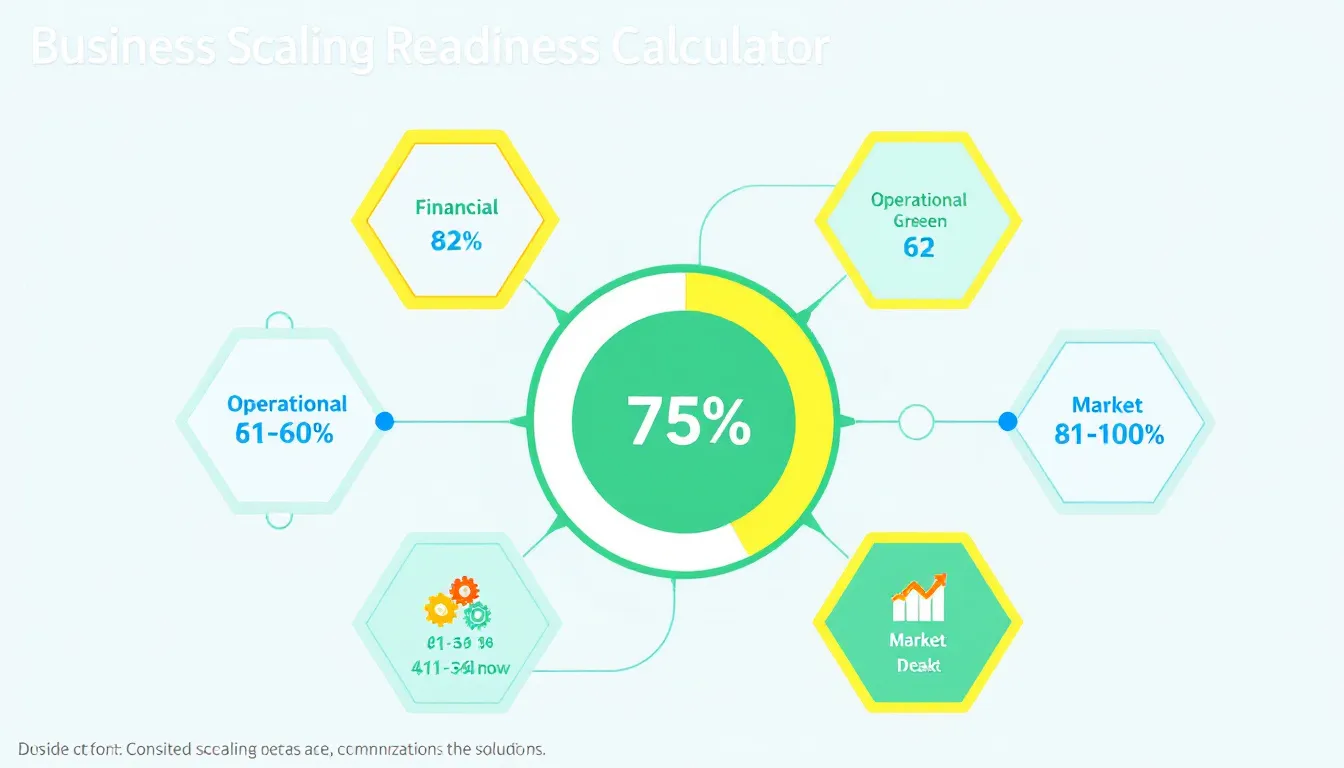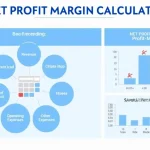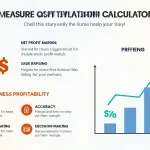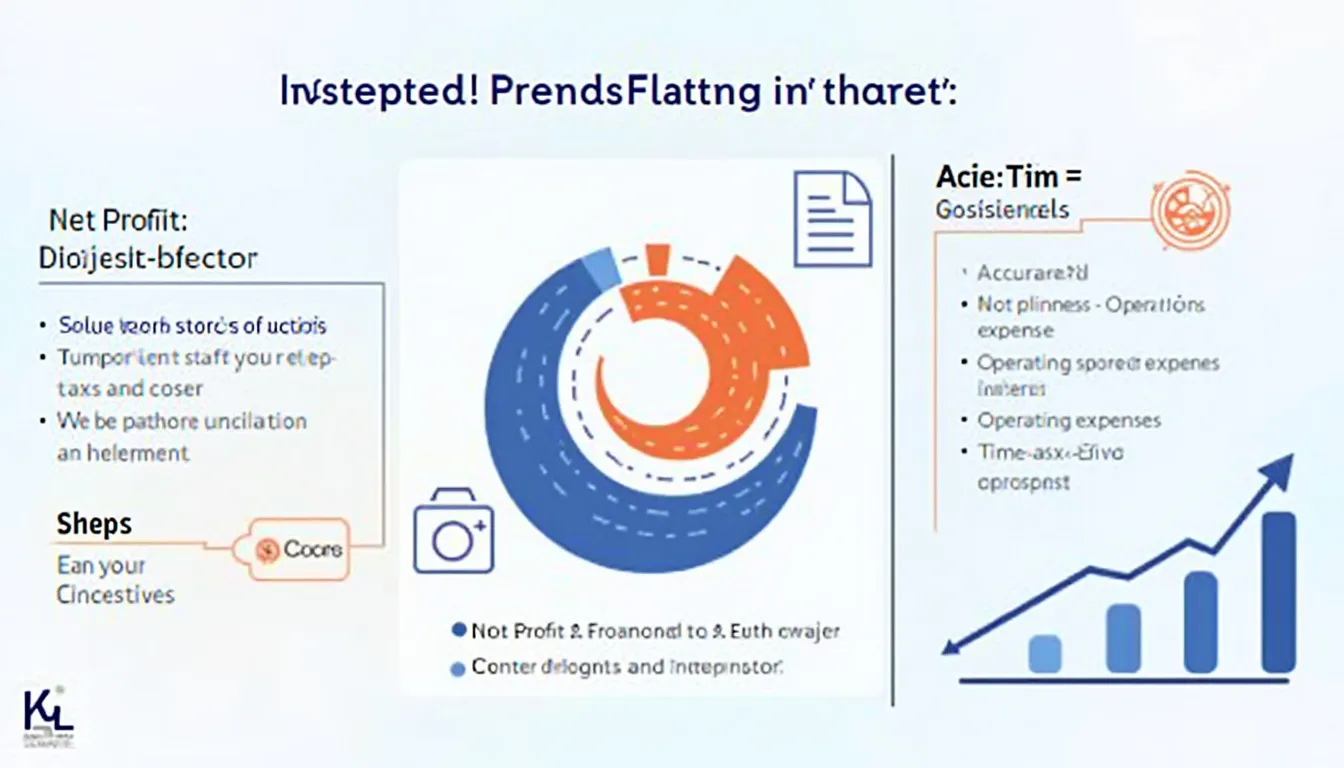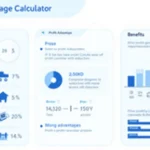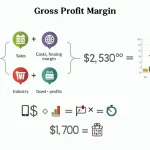Business Scaling Readiness Calculator
Is this tool helpful?
How to Use the Business Scaling Readiness Calculator Effectively
Step-by-Step Guide
To make the most of the Business Scaling Readiness Calculator, follow these steps:
- Gather Financial Data:
- Annual Revenue: Enter your current year’s total revenue (e.g., $2,500,000)
- Previous Year’s Revenue: Input last year’s total revenue (e.g., $2,000,000)
- Net Profit: Enter your current year’s net profit (e.g., $300,000)
- Operational Metrics:
- Actual Output: Input the number of units produced in the current period (e.g., 15,000 units)
- Potential Output: Enter the maximum number of units that can be produced with current resources (e.g., 18,000 units)
- Market Information:
- Current Market Size: Estimate the total market size for the current year (e.g., $50,000,000)
- Previous Market Size: Enter the estimated market size from the previous year (e.g., $45,000,000)
- Organizational Data:
- Current Number of Employees: Input your current workforce size (e.g., 85 employees)
- Previous Number of Employees: Enter the number of employees from the previous year (e.g., 75 employees)
- Technological Assessment:
- Level of Automation: Select your self-assessed rating of technological automation on a scale of 1 to 5
- Calculate Results: Click the “Calculate Scaling Readiness” button to generate your results.
- Interpret the Output: Review your overall scaling readiness score, factor scores, and recommendations.
Understanding the Business Scaling Readiness Calculator
Definition and Purpose
The Business Scaling Readiness Calculator is a comprehensive tool designed to help business owners, entrepreneurs, and managers assess their company’s preparedness for growth and expansion. By analyzing key metrics across five crucial domains – financial, operational, market, organizational, and technological – this calculator provides a holistic view of a business’s scaling potential.
The primary purpose of this tool is to:
- Evaluate current business performance across multiple dimensions
- Identify strengths and weaknesses in scaling readiness
- Provide actionable insights for improvement
- Guide strategic decision-making for growth initiatives
Benefits of Using the Calculator
Utilizing the Business Scaling Readiness Calculator offers numerous advantages:
- Comprehensive Assessment: By considering multiple factors, the calculator provides a well-rounded view of your business’s scaling potential.
- Data-Driven Insights: The tool transforms raw data into meaningful scores and recommendations, enabling informed decision-making.
- Identifying Growth Barriers: Pinpoint specific areas that may hinder scaling efforts, allowing for targeted improvements.
- Benchmarking: Compare your business’s performance against industry standards and best practices for scaling.
- Strategic Planning: Use the results to develop a roadmap for scaling your business effectively.
- Risk Mitigation: By highlighting potential weaknesses, the calculator helps in preemptively addressing scaling challenges.
- Resource Allocation: Prioritize investments and efforts in areas that need the most attention for successful scaling.
- Confidence Building: Gain assurance in your scaling decisions based on quantitative analysis.
Addressing User Needs and Solving Specific Problems
Financial Readiness Assessment
The calculator evaluates financial readiness through two key metrics:
1. Revenue Growth Rate
This metric indicates the business’s financial momentum and is calculated using the following formula:
$$\text{Revenue Growth Rate} = \frac{\text{Current Revenue} – \text{Previous Revenue}}{\text{Previous Revenue}} \times 100\%$$For example, if your current revenue is $3,000,000 and the previous year’s revenue was $2,500,000:
$$\text{Revenue Growth Rate} = \frac{3,000,000 – 2,500,000}{2,500,000} \times 100\% = 20\%$$This 20% growth rate would receive a score of 100 in the calculator, indicating strong financial momentum for scaling.
2. Profit Margin
Profit margin assesses the business’s profitability and is calculated as follows:
$$\text{Profit Margin} = \frac{\text{Net Profit}}{\text{Revenue}} \times 100\%$$For instance, if your net profit is $450,000 and revenue is $3,000,000:
$$\text{Profit Margin} = \frac{450,000}{3,000,000} \times 100\% = 15\%$$This 15% profit margin would also receive a score of 100, suggesting strong profitability to support scaling efforts.
Operational Capacity Evaluation
The calculator assesses operational readiness through the Capacity Utilization Rate:
$$\text{Capacity Utilization Rate} = \frac{\text{Actual Output}}{\text{Potential Output}} \times 100\%$$For example, if your actual output is 16,000 units and potential output is 20,000 units:
$$\text{Capacity Utilization Rate} = \frac{16,000}{20,000} \times 100\% = 80\%$$An 80% capacity utilization rate would receive a score of 75, indicating room for growth but also the need for careful planning to handle increased demand.
Market Potential Analysis
The calculator evaluates market readiness through the Market Growth Rate:
$$\text{Market Growth Rate} = \frac{\text{Current Market Size} – \text{Previous Market Size}}{\text{Previous Market Size}} \times 100\%$$If the current market size is $60,000,000 and the previous market size was $55,000,000:
$$\text{Market Growth Rate} = \frac{60,000,000 – 55,000,000}{55,000,000} \times 100\% \approx 9.09\%$$This 9.09% market growth rate would receive a score of 75, suggesting favorable but not exceptional market conditions for scaling.
Organizational Capacity Assessment
The calculator evaluates organizational readiness through the Employee Growth Rate:
$$\text{Employee Growth Rate} = \frac{\text{Current Employees} – \text{Previous Employees}}{\text{Previous Employees}} \times 100\%$$For instance, if you currently have 95 employees and had 85 employees in the previous year:
$$\text{Employee Growth Rate} = \frac{95 – 85}{85} \times 100\% \approx 11.76\%$$This 11.76% employee growth rate would receive a score of 75, indicating solid organizational expansion to support scaling efforts.
Technological Readiness Evaluation
The calculator assesses technological readiness based on the self-reported Level of Automation, with scores assigned as follows:
- 5 (Fully automated): Score = 100
- 4 (Mostly automated): Score = 80
- 3 (Partially automated): Score = 60
- 2 (Minimally automated): Score = 40
- 1 (Not automated): Score = 20
Overall Scaling Readiness Score Calculation
The calculator computes the overall scaling readiness score using weighted averages of individual factor scores:
$$\text{Scaling Readiness Score} = (0.25 \times \text{Financial Score}) + (0.20 \times \text{Operational Score}) + (0.20 \times \text{Market Score}) + (0.15 \times \text{Organizational Score}) + (0.20 \times \text{Technological Score})$$For example, if the individual scores are:
- Financial Score: 87.5 (average of Revenue Growth and Profit Margin scores)
- Operational Score: 75
- Market Score: 75
- Organizational Score: 75
- Technological Score: 80 (assuming “Mostly automated”)
The overall scaling readiness score would be:
$$\text{Scaling Readiness Score} = (0.25 \times 87.5) + (0.20 \times 75) + (0.20 \times 75) + (0.15 \times 75) + (0.20 \times 80) = 79.375\%$$This score of 79.375% suggests that the business is very close to being ready for scaling, with recommendations to address areas with lower scores to improve overall readiness.
Practical Applications and Use Cases
1. Startup Scaling Assessment
A technology startup experiencing rapid growth can use the calculator to assess if they’re ready for a significant expansion. By inputting their financial data, current operational capacity, market size estimates, employee numbers, and automation level, they can get a comprehensive view of their scaling readiness. This information can be crucial when pitching to investors or planning resource allocation for scaling efforts.
2. Franchise Expansion Evaluation
A successful local restaurant chain considering expanding to new locations can utilize the calculator to evaluate their readiness for scaling. By analyzing their financial growth, operational efficiency, market potential in new areas, organizational capacity to support new locations, and current level of technological integration, they can make an informed decision about the timing and extent of their expansion plans.
3. Manufacturing Capacity Planning
A manufacturing company facing increased demand can use the calculator to assess if they’re prepared to scale up production. By evaluating their financial stability, current capacity utilization, market growth trends, workforce expansion capability, and level of automation, they can determine if they’re ready to invest in new equipment or facilities to meet the growing demand.
4. E-commerce Business Scaling
An online retailer experiencing steady growth can employ the calculator to evaluate their readiness for a major scaling initiative, such as expanding to international markets or significantly broadening their product range. The tool can help them assess if their financial resources, operational infrastructure, market potential, organizational structure, and technological capabilities are sufficient to support such a significant scaling effort.
5. Service Industry Expansion
A consulting firm considering opening new offices in different cities can use the calculator to assess their scaling readiness. By analyzing their financial performance, current workload capacity, market potential in new locations, ability to hire and train new consultants, and technological infrastructure to support remote work and collaboration, they can make a data-driven decision about their expansion strategy.
Frequently Asked Questions (FAQ)
Q1: How often should I use the Business Scaling Readiness Calculator?
A1: It’s recommended to use the calculator quarterly or bi-annually to track your progress and readiness for scaling. However, you may want to use it more frequently if you’re actively working on improving specific areas or if your business is experiencing rapid changes.
Q2: Can this calculator be used for all types of businesses?
A2: Yes, the Business Scaling Readiness Calculator is designed to be versatile and applicable to various industries and business models. However, the interpretation of results may vary depending on your specific industry benchmarks and growth patterns.
Q3: How should I interpret the overall scaling readiness score?
A3: The overall score provides a general indication of your business’s readiness to scale:
- 80% or higher: Your business is ready to scale
- 60-79%: Your business is close to being ready, with some areas needing improvement
- 40-59%: Significant improvements are needed before scaling
- Below 40%: Your business is not ready to scale and requires substantial work in multiple areas
Q4: What should I do if I get a low score in one particular area?
A4: A low score in a specific area indicates a potential barrier to scaling. Focus on developing strategies to improve that particular aspect of your business. For example, if you score low in the technological category, consider investing in automation or digital transformation initiatives.
Q5: Does a high overall score guarantee successful scaling?
A5: While a high score indicates strong readiness for scaling, it doesn’t guarantee success. Scaling a business involves many factors, including market conditions, competition, and execution of growth strategies. The calculator provides a solid foundation for decision-making, but it should be used in conjunction with other business analysis tools and expert advice.
Q6: How can I improve my scaling readiness score?
A6: To improve your score, focus on the areas where you scored lowest. This might involve:
- Implementing strategies to increase revenue and profitability
- Optimizing operations to improve capacity utilization
- Conducting market research to identify growth opportunities
- Investing in employee training and development
- Upgrading technology and automation systems
Q7: Can I compare my results with other businesses?
A7: While the calculator provides a standardized scoring system, direct comparisons with other businesses should be made cautiously. Factors such as industry, business size, and stage of growth can significantly impact scaling readiness. It’s more valuable to track your own progress over time and compare against industry benchmarks when available.
Q8: How does the calculator account for industry-specific factors?
A8: The calculator uses general metrics that are applicable across various industries. However, you should interpret the results in the context of your specific industry. For example, what constitutes a high growth rate or profit margin can vary significantly between industries.
Q9: Is there an ideal time to scale a business?
A9: The ideal time to scale varies for each business. Generally, it’s when you have a proven business model, stable financials, strong market demand, and the operational capacity to support growth. The calculator helps you assess if these conditions are met, but the decision should also consider external factors and your business goals.
Q10: How can I use the radar chart effectively?
A10: The radar chart visually represents your scores across the five main factors. Use it to quickly identify areas of strength and weakness. Areas with lower scores (closer to the center of the chart) are prime candidates for improvement efforts. The chart can also be useful for tracking progress over time by comparing charts from different periods.
Important Disclaimer
The calculations, results, and content provided by our tools are not guaranteed to be accurate, complete, or reliable. Users are responsible for verifying and interpreting the results. Our content and tools may contain errors, biases, or inconsistencies. We reserve the right to save inputs and outputs from our tools for the purposes of error debugging, bias identification, and performance improvement. External companies providing AI models used in our tools may also save and process data in accordance with their own policies. By using our tools, you consent to this data collection and processing. We reserve the right to limit the usage of our tools based on current usability factors. By using our tools, you acknowledge that you have read, understood, and agreed to this disclaimer. You accept the inherent risks and limitations associated with the use of our tools and services.
